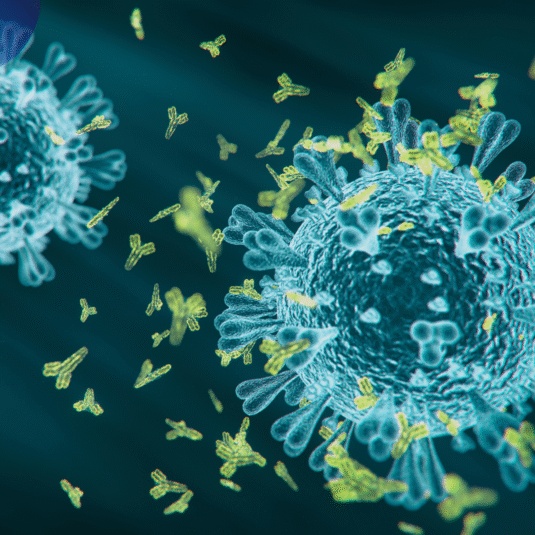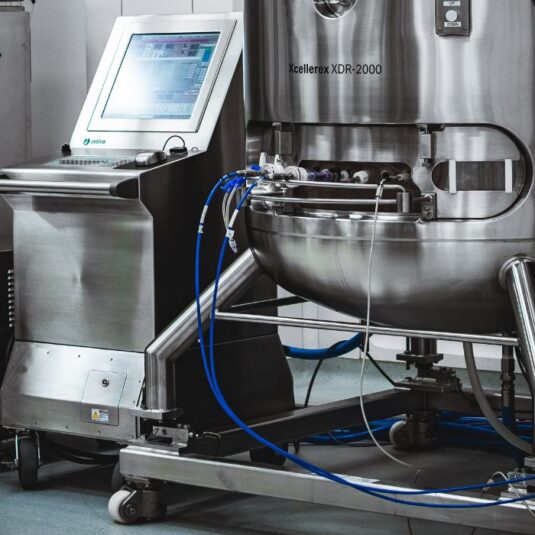In-Process Testing for Drugs in the Pharmaceutical Industry
Analytics, Drug development
- Reliable in-process testing ensures consistent product quality, faster development, and regulatory readiness. Advanced analytics integrated into GMP-compliant platforms empower manufacturers to control complexity and deliver high-quality biologics with confidence.
- In the biopharma industry, particularly in the production of biologics like monoclonal antibodies, in-process testing and real-time monitoring play a vital role in maintaining product quality, safety, and compliance.
In-Process Testing Is Critical in Pharmatherapeutics Development
Biologics manufacturing involves living systems, making process variability an inherent challenge. In-process testing mitigates this risk by providing real-time insight into CQAs such as glycosylation patterns, aggregation, and potency during production. These controls not only align with EMA and FDA regulatory frameworks but are essential for demonstrating a validated and reproducible process. According to recent analyses, proactive in-process controls reduce overall batch failure rates by up to 30%, enhancing supply security and reducing cost of goods.1 Mabion integrates these analytics into its GMP services to ensure robust, compliant biologics production.
Key Parameters Monitored During In-Process Testing
The development and manufacturing of biologic drugs require rigorous in-process control to ensure product quality, safety, and regulatory compliance. In-process testing serves as an essential quality gate, providing real-time insight into process performance and product integrity.2 By monitoring critical process parameters (CPPs) and critical quality attributes (CQAs) throughout upstream, harvest, and downstream operations, in-process testing enables early detection of deviations, reduces variability, and supports a robust process validation strategy.
| Parameter | Orthogonal Testing Methods |
| pH | pH Meter with Calibrated Electrode, pH Indicator Strips, Potentiometric Titration |
| Osmolality | Freezing Point Depression Osmometer, Vapor Pressure Osmometer, Membranous Osmometry, Refractometry |
| Bioburden | qPCR assay for Microbial DNA, Mycoplasma testing, Membrane Filtration with Growth Media, Flow Cytometry |
| Endotoxin | LAL Turbidimetric Assay, LAL Chromogenic Assay, LAL Gel-Clot Assay |
| Protein Concentration | UV Absorbance (at 280 nm), microBCA Assay, Amino Acid Analysis, ELISA for specific protein concentration |
| Glycosylation Profile | HILIC-UPLC with Fluorescent Labeling, LC-MS/MS Glycan Mapping, MALDI-TOF MS |
| Aggregation | SEC-HPLC, Dynamic Light Scattering |
| Cell Viability | Automated Cell Counters, Flow Cytometry, Trypan Blue staining in Hemocytometer |
By applying Design of Experiments, manufacturers can define design space boundaries that ensure product quality under variable conditions, aligning with ICH Q8(R2) and Q11 guidelines. It enables statistically guided experimentation, reducing the number of trials needed while maximizing information gain and supports continuous improvement by pinpointing optimal conditions for yield, purity, and consistency.4,5
In-Process Control Improve Final Product Quality
Depending on the stage of process development, different analytical tests are performed. During the cell culture phase, in-process testing ensures the controlled growth and productivity of the cell line producing the drug.6 Key analyses include cell viability and density, typically determined using trypan blue exclusion, automated cell counters, or flow cytometry. pH and dissolved oxygen are continuously monitored through inline probes to maintain optimal culture conditions.
The harvest stage introduces further quality checkpoints to ensure removal of impurities and readiness for downstream purification. Key analyses include pH and osmolality, as well as turbidity, which reflects particulate load post-clarification. Host cell protein (HCP) and host cell DNA are monitored using ELISA and qPCR, respectively, to verify reduction of process-related impurities. Endotoxin testing is conducted using Limulus Amebocyte Lysate (LAL)-based assays to comply with pharmacopeial standards for parenteral products.7
Downstream biorocessing are critical for achieving the high purity standards required for therapeutics. In-process testing during purification steges include protein concentration measurements (UV absorbance at 280 nm or BCA assay), as well as aggregate detection using Size Exclusion Chromatography (SEC-HPLC) or Dynamic Light Scattering (DLS). Charge variant analysis via Ion-Exchange Chromatography or Capillary Zone Electrophoresis ensures consistency in isoform distribution. Additional tests for residual Protein A (using ELISA), endotoxin, and bioburden confirm removal of contaminants.3,7 Before batch release, analytics verify the final composition and stability of the product. Assays include appearance, color, pH, osmolality, and sterility tests for contamination control.1
Tools and Technologies Used in Real-Time Drug Monitoring
As drug manufacturing becomes increasingly complex, real-time access to process data allows for immediate intervention, helping ensure batch consistency and robust quality control.
Process analytical technology (PAT) is a cornerstone of in-process testing strategies. Endorsed by both FDA guidelines and EMA regulations, PAT enables the real-time collection and analysis of process data, particularly for monitoring critical quality attributes (CQAs). This includes parameters such as protein concentration, pH, and metabolite levels. PAT tools-ranging from UV-Vis and Raman spectroscopy to chromatographic systems-provide accurate and timely insights into the manufacturing process. When integrated into drug manufacturing, PAT supports GMP compliance by reducing variability, enhancing batch consistency, and enabling real-time monitoring that aligns with Quality by Design (QbD) principles.8
Real-time biochemical analysis is essential for upstream in-process testing in drug manufacturing. Instruments such as online bioanalyzers continuously measure key culture parameters that directly affect cell viability and product yield. These systems provide data-driven control over feeding strategies and metabolic shifts, enhancing batch consistency and reducing the risk of process deviations. Their compatibility with automated data logging also supports GMP compliance, reinforcing the role of real-time monitoring in high-quality biologics production.
Soft sensors, combined with multivariate data analysis (MVDA), represent a digital evolution in in-process testing. By applying statistical models to process data, soft sensors estimate variables that cannot be directly measured in real time. MVDA enables comprehensive evaluation of CPPs and CQAs across the entire production lifecycle.9 These advanced analytics tools are aligned with both FDA guidelines and EMA regulations, enhancing process understanding and ensuring control over pharmaceutical testing methods. Their application strengthens quality control and contributes to efficient, reproducible drug manufacturing workflows.
Regulatory Requirements for In-Process Testing – EMA and FDA Guidelines
Within the European regulatory framework, the European Medicines Agency (EMA) places strong emphasis on the integration of in-process testing (IPT) into all stages of biologic drug manufacturing, particularly for products like monoclonal antibodies. According to the EU Guidelines for Good Manufacturing Practice, Annex 2 (for biological products) requires manufacturers to define critical process parameters (CPPs) and implement in-process controls that monitor these parameters in real time or at-line to ensure consistent performance. For sterile biologics, Annex 1 additionally mandates in-process microbiological monitoring and environmental control to maintain aseptic conditions. Furthermore, the EMA Process Validation Guideline for Finished Products promotes a lifecycle approach to validation, with IPT forming a critical part of ongoing process verification.1 The EMA also aligns with ICH guidelines, such as ICH Q6B, which defines specifications for biologic products, and ICH Q8(R2), which supports the use of process analytical technology (PAT) and real-time monitoring to control critical quality attributes (CQAs).6 These standards reflect a regulatory expectation for science-based, risk-managed production oversight.
In the United States, the Food and Drug Administration (FDA) outlines its requirements for in-process testing in 21 CFR Part 211, which mandates control procedures to monitor output and validate the performance of manufacturing processes. These regulations require testing at appropriate stages to verify identity, strength, quality, and purity of both the in-process material and the final product. The FDA further specifies the expectations of a three-stage validation lifecycle – process design, process qualification, and continued process verification – where IPT plays a central role, especially in Stages 2 and 3.5 The FDA also supports the use of PAT tools, encouraging the adoption of real-time and multivariate monitoring systems to improve quality control, reduce variability, and support GMP compliance.10 These measures align with modern pharmaceutical testing methods and reflect a shift toward proactive, data-driven oversight in biologics manufacturing.
Risks and Limitations in In-Process Testing
One of the key limitations of in-process testing is the potential for incomplete coverage of critical quality attributes (CQAs) and process variables. Not all attributes can be measured in real time or at-line due to limitations in technology, assay sensitivity, or sample accessibility. As a result, some quality-relevant data may only be available retrospectively through final product testing, limiting the effectiveness of in-process testing in preventing deviations or ensuring immediate corrective actions.11
While real-time monitoring generates large volumes of process data, the ability to effectively integrate and interpret this data remains a challenge. Complex datasets from spectroscopy, soft sensors, or multivariate tools require advanced analytics and experienced personnel to extract meaningful insights. Without robust data management systems and statistical models, the risk of misinterpretation or delayed response increases, potentially compromising quality control and batch consistency.
Conclusions
In-process testing transforms drug manufacturing from reactive to predictive improving patient outcomes. As regulators demand greater process understanding, comprehensive in-process controls are indispensable for successful biologics commercialization. Robust in-process testing is not only a compliance necessity but a strategic advantage in ensuring safe, effective, and reproducible biologic products.
A trusted CDMO partner with full GMP capabilities ensures in-process testing meets global standards. Submit your RFP to explore how Mabion can support your next biologic.
Prepared by:

Jakub Knurek
Marketing Specialist
References
- European Medicines Agency, Scientific guideline on process validation for finished products, 2014.
- Ambrogelly A, Gozo S, Katiyar A, Dellatore S, Kune Y, Bhat R, Sun J, Li N, Wang D, Nowak C, Neill A, Ponniah G, King C, Mason B, Beck A, Liu H. Analytical comparability study of recombinant monoclonal antibody therapeutics. MAbs. 2018; 10: 513-538.
- ICH, Q6B Specifications: test procedures and acceptance criteria for biotechnological/biological products, 1999.
- Wójcik-Bojek U. Enhancing biotechnological research with Design of Experiments. Mabion Science Hub, 2024.
- U.S. Food and Drug Administration, Process Validation: General Principles and Practices Guidance, 2011.
- Maruthamuthu MK, Rudge SR, Ardekani AM, Ladisch MR, Verma MS. Process Analytical Technologies and Data Analytics for the Manufacture of Monoclonal Antibodies. Trends Biotechnol. 2020; 38: 1169-1186.
- US Pharmacopeia <85> Bacterial Endotoxins, 2012.
- Gillespie C, Wasalathanthri DP, Ritz DB, Zhou G, Davis KA, Wucherpfennig T, Hazelwood N. Systematic assessment of process analytical technologies for biologics. Biotechnol Bioeng. 2022; 119: 423-434.
- Xu X, Farnós O, Paes BCMF, Nesdoly S, Kamen AA. Multivariate data analysis on multisensor measurement for inline process monitoring of adenovirus production in HEK293 cells. Biotechnol Bioeng. 2024; 121: 2175-2192.
- U.S. Food and Drug Administration, PAT — A Framework for Innovative Pharmaceutical Development, Manufacturing, and Quality Assurance Guidance, 2004.
- Kim EJ, Kim JH, Kim MS, Jeong SH, Choi DH. Process Analytical Technology Tools for Monitoring Pharmaceutical Unit Operations: A Control Strategy for Continuous Process Verification. Pharmaceutics. 2021; 13: 919.
Related resources

Biologics Characterization for Ensuring Product Quality and Consistency
Analytics, Biologics

Monoclonal Antibody Prophylaxis for Infectious Diseases – Passive Immunization and Prevention
Monoclonal antibody, Vaccines

End-to-End Manufacturing of Biosimilars – From Cell Line to Commercial Product
Biosimilars, Manufacturing